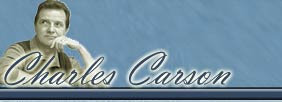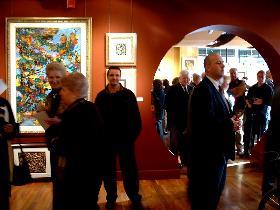
2003- Charles Carson, exposure Solo to the Art gallery Richelieu street St-Denis, Montreal, Qc.
|
Experts in art by: Terry Santer
"Carsonism and Mosaic"
As early as 1990, Louis Bruens and several colleagues, Guy Robert and Jacques de Roussan, all three art historians and consultants, could discern through the work of Charles Carson “an artist of the calibre of Riopelle, if not in fact superior to that master.”
However, as Guy Robert explained, “The work Charles Carson is doing can be clearly distinguished from that of a Riopelle as it takes us to the border lying between the abstract and the figurative (…). In so doing we are able to avoid the old quarrel that has so often arisen between them; indeed it might be said that, with Carson, a reconciliation takes place.”
Robert went on to explain that, preferring to use acrylic paint to the spatula, “Carson, slicing like a blade to the core of the matter, launches himself onto each blank canvas via the rapid and nervous dance of his hand, using layered touches nearly always on the diagonal or in wide ellipses.”
From this way of doing things, à la Carson, “comes an impression of such freshness, such dynamism, and what rhythm (…)!” that a new –ism- is of necessity required by art experts. Hence Carsonism!
|
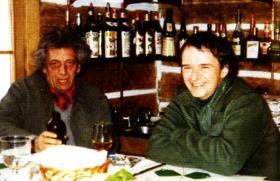
Riopelle and Guy Robert
at Sainte-Marguerite, 1989
|
"The Founder of the Museum of Contemporary art of Montreal describes Carsonisme admirably"
Guy Robert
(1933-2000 ),
Author, art historian and critic Guy ROBERT he has published books on art and poetry, and livres d'artistes illustrated with original prints. His best - known works include studies on Riopelle, Pellan, Borduas, Dallaire, Fortin, Lemieux, Dumouchel, and Bonet; and more...
|
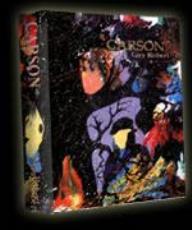
Publication Iconia 1993
Launching of the book, "Carson a discovery... Carsonisme" with the Museum Vaudreuil Soulange, Qc. Canada 1993
By the writer and historian of art Mr. Guy Robert, he was a member of the Federal Cultural Policy Review Committee from 1979 to 1982, has sat on the Canadian Cultural Property Board, and has been awarded Montreal's literary Grand Prix. |
It’s not that Carson is trying to impose a new pictorial language on anyone! It’s more because he is so unclassable to begin with, so unique is his form of writing.
As the art historian Guy Robert has commented: “On the border line between abstract and figurative already mentioned, Carson gives each painting an extraordinary depth that is much more fascinating than the most masterful system of perspective.”
“The impression of freshness and energy we find in Carson’s paintings comes in part from the brightness and purity of the colours, harmonised in a rhythmic and airy juxtaposition by patches of white.”
“The placement of broad strokes (…) seems to be raised up by some mysterious breath, discreet yet efficacious, animating the whole composition.”
Guy Robert highlights another characteristic of Carsonism: “It is also fascinating to see how the artist, without having recourse to the artifice of perspective, creates a most original impression of depth by giving the illusion of a continual shimmering, a sort of curving of the visual space and a mobility to the schema by means of this energetic and harmonious disposition of mass.”
“…The discovery of work like that of Carson is akin to the anticipation one feels at the approach of a long-awaited springtime!”
|
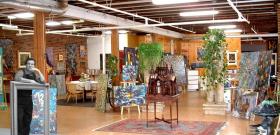
Studio of Charles
Carson, Old-Montreal, Qc. Canada |
Louis BRUENS, "Carson has created a new style - more than that, he has developed a completely new pictorial language that makes an appearance on the scale of artistic values in a way that has nothing to do with the current directions, genres or styles that are mostly found in today's art market".
Here we have a new way of painting that takes its proper place in the mainstream of contemporary art but in a form that is universally accessible.
|
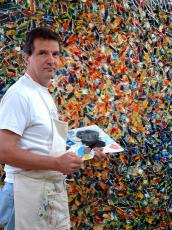
Charles Carson in front of his work of mosaic style entitled: "Douce rizière au souffle d'automne glacé"
Format: 71"X 56" |
Thought of the artist: 2004
Art to paint of in is forgotten the matter, it does not exist...is only light, shade and colors with the reflections multiple.
Thought of the artist: 2003
"My paintings are a spontaneous projection of what I am feeling; I stand before each new canvas like a writer facing a blank page."
Thought of the artist: 1992
I do not believe owe me exhiber in public, I do not see either the interest which a true collector could carry to my childhood, my life or my matrimonial statute. The actor must himself in person with his public. The singer also must himself to his public and to his listener, just like the dancer and the leader. The painter him, and in particular the painter of workshop, are not a public entertainer and I really believe that only the matter must speak for him. I am a painter and only my painting will have to say my thoughts, my emotions and my dreams. I wish only one thing, to see the product of my research, my work, my joys and my sorrows, my works, to bring the sun and the life in each residence.
|
|
|
|
